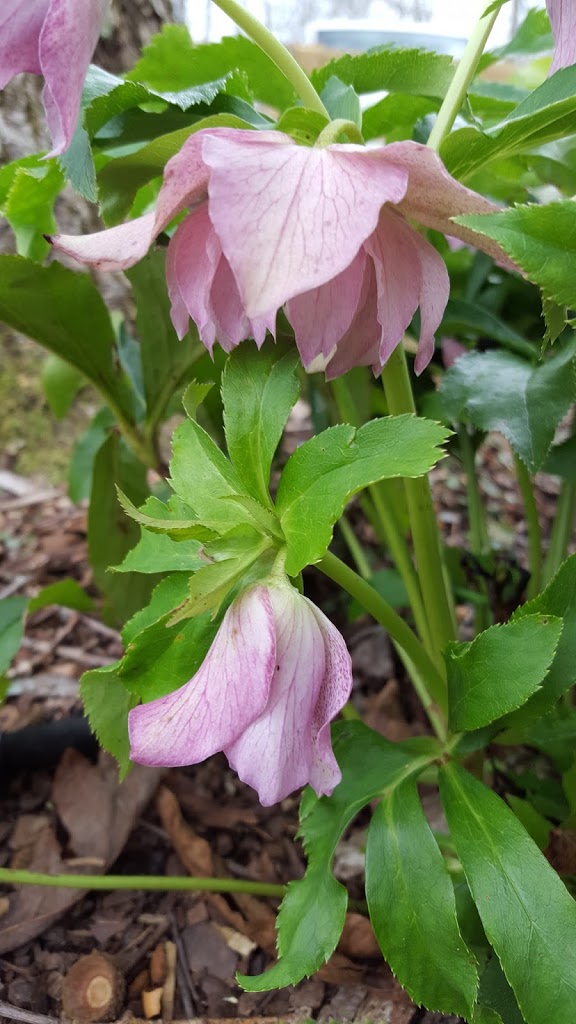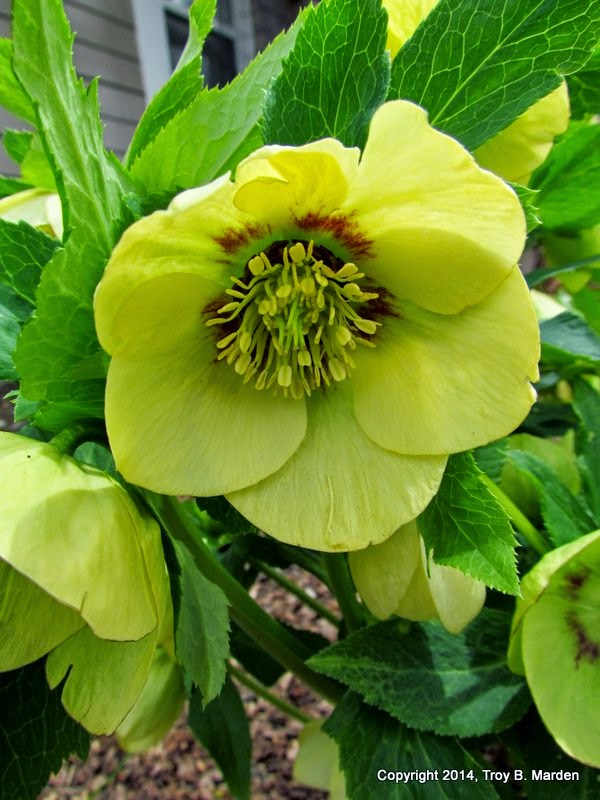What happened to winter?
I’ve had so many messages either by email or on Facebook that I thought addressing everyone’s concerns here would be a great way to officially re-launch the blog just before the first of the year. So, here we go.
El Nino. El Nino is what happened to winter. Hanging out over the northern Pacific, El Nino has rearranged our “normal” (whatever that is these days) winter weather pattern and brought the warmest, mildest late autumn and early winter (remember, winter did just officially start one week ago today) in recent memory. Considering that the past two winters have been two of the coldest and snowiest on record in at least the past 25 years–and in some places much longer–this one is feeling quite tropical! I did work in the garden most of the day yesterday in a short-sleeved t-shirt, after all!
No need to belabor the fact that it is warm, though. We all know that by looking around at the garden. Things are happening that just shouldn’t be happening at this time of year and we’re concerned, right? Right. Well, mostly right. Some things are happening just the way they’re intended to, while others are cause for some concern, so let’s try to sort that out.
What am I worried about? None of it, really. Plants are resilient characters. Do I have some plants that are blooming far earlier due to the incredibly mild temperatures we’ve experienced so far this season? Yes. Is there anything I can do about it? No. Will my plants die because of it? In all but the rarest cases, they will not. Yes, I’ll lose some blooms. Yes, the buds on the quince that are expanded FAR too much for this early in the season will probably freeze and I’ll have little to no show in a couple of months when it should be the star of the garden, but those are the breaks. That’s life in the garden.
Will the Lenten roses survive? Yes. Will their flowers get frozen? Some of them, yes, but it really depends on the plant. Helleborus niger, for instance (aka the Christmas rose), is flowering absolutely normally and at just the right time of year. You can’t fool it, and the temperatures can get well down into the twenties and even the upper teens (Fahrenheit, for those of you who read the blog in other parts of the world–we still use it here) and the blooms will be just fine. If a few of the wide open blooms get frozen, more buds will appear from below ground and new flowers will appear. This is especially true of the newer hybrids like ‘Jacob’ and ‘Josef Lemper’.
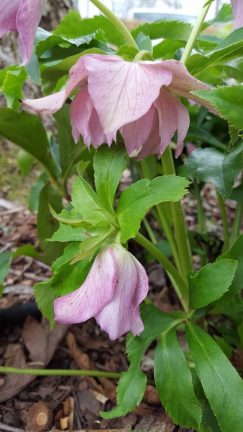 |
| Helleborus orientalis ‘Sally’. These fully open blooms will hold up well, even down into the 20’s, but if we get into the teens, the blooms will probably be lost. The plant, however, will re-grow normally in the spring. |
I’m a little more concerned about some of Helleborus x hybridus types that are flowering WELL ahead of their normal season, which usually doesn’t begin until late February. They are fully two months early and some have flowers completely open. These will probably get frozen, as we’ll most assuredly have some temperatures cold enough to kill the open flowers. Those that are tightly budded and whose buds are still hovering at ground level will be just fine. They’re built to withstand the cold, so don’t despair! And even for those with flowers fully open, the plants themselves are not at risk. You may lose this year’s blooms, but the plant will grow normally in spring and will get right back to its normal cycle next year.
What about the cherries and the forsythia and the winter jasmine that I see blooming around town? What will happen to those? What about my saucer magnolia? It already has blooms, you know!
The answers to these questions vary, but here’s the gist of it. The cherries you’re seeing in “full” bloom now are almost certainly one of two varieties–Prunus subhirtella var. autumnalis or a hybrid called ‘Hally Jolivette’. It is PERFECTLY NORMAL for either or both of them to flower during the mild days of autumn and into winter when we have one as mild as we’ve had this year. If you have ‘Yoshino’ or ‘Kwanzan’ cherries (far more common in the landscape), you’ll notice that they are still tightly budded. They’ll flower in spring at their normal time because they have to have a certain amount of cold weather to break their dormancy. We haven’t had that cold weather, yet, so they’re hanging out, cooling their heels until we do. Plants are so smart! The same applies to your apple trees, pear trees, fruiting cherries and plums, etc. etc. They have built in mechanisms that keep them from flowering too early and getting frozen (late spring frosts can get them, but they’ll rarely–if ever–bloom in winter). As for forsythia, a few blooms may open now, but most will be saved for later. No worries there. And the winter jasmine (Jasminum nudiflorum) is a risk-taker, anyway. Some years we get a full show and some years we don’t. Enjoy it now! The same goes for the saucer magnolias. You can’t cover a big tree with a sheet and its blooms are so cold sensitive that it wouldn’t do you any good, even if you could. Choose your battles!
I am sad about my quince. Its spring show is one that I look forward to every year, but its buds–while still tightly closed–are expanded so far that they are showing color. If winter continues to be mild and we don’t experience temperatures too far down into the teens, I may be lucky enough to still get a show. Quince is very tough! But– when the buds are expanded far enough to show color, they are much more susceptible to cold damage, so I’ll just hope for the best.
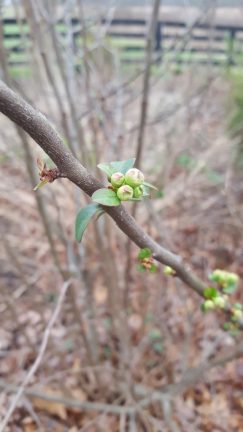 |
| The quince is really budded up and even showing some color. I figure it has a 50/50 chance of flowering. If temperatures cool down, the buds can stay like this indefinitely and bloom normally in late February or early March. However, they’re showing quite a bit of color and if we have temperatures down into the single digits (or even low teens) the show is probably over for this year. These things do happen! |
Some plants that I am truly concerned about in the garden are some of the ephemeral spring wildflowers. While doing some cleanup yesterday, I found Trillium luteum, our native yellow trillium, pushing well through the surface of the mulch. This is at least two-and-a-half months ahead of schedule. I’d be concerned seeing it before mid-March in my climate. The same for the bloodroot. Already up! Just breaking the soil surface, but up, nonetheless. And of course, it isn’t just the old run-of-the-mill bloodroot. No. That’s too smart and is still below ground. It’s the somewhat rare, incredibly slow and sickeningly expensive double-flowering form that has decided to stick its nose out of the ground 3 months before it normally makes an appearance. These will get a little extra mulch over the top of them today and they’ll be fine, as long as I’m diligent and make sure that winter rain and wind doesn’t expose the tender growing points before we have a little warmer weather again in March.
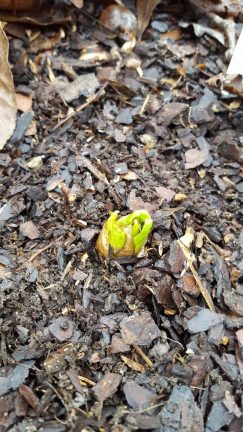 |
| This Trillium luteum, the yellow trillium, I am truly concerned about and will cover with mulch. It is usually not at this point of emergence until sometime in March! |
I’m also a little concerned about Asarum maximum ‘Ling Ling’. It can be somewhat tender and has not gone dormant. In fact, it’s in full bloom! Usually, this is a very early spring bloomer here, but the mild winter has prompted it into flower now. I’m not worried about losing the blooms. That happens. But I do worry that the plants are not fully dormant and that a sudden temperature plunge may do significant damage. They’ll get some evergreen branches (leftover from Christmas) laid over them before the weather gets too cold.
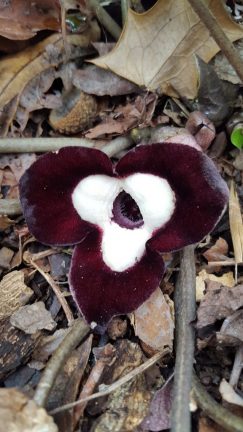 |
| I’m also a little concerned about Asarum maximum ‘Ling Ling’. It can be tender here and is obviously not dormant. I don’t care so much about losing the blooms–even though they are incredibly cool!–but I don’t want to lose the plants. They’ll get a light covering of evergreen boughs (leftover Christmas greens) to protect them. |
One mid-winter bloomer that is right on schedule and that I am always happy to see is Mahonia bealei, the leatherleaf mahonia. I’ll get some flack for saying that I love it, I’m sure, since it is on the invasive exotic plant list in many areas, but here’s the flip side to that story. Leatherleaf mahonia (and all of its hybrids and related species) are laden with nectar and pollen. On these warm winter days, they are one of the few things flowering in the garden that the honeybees can collect from. My plants were so full of honeybees yesterday that from 10 feet away, you could hear them buzzing all over the plants. If you’re concerned about them being invasive or don’t want the hassle of pulling seedlings from the garden, take 15 minutes one day and go out–after all of the flowers have fallen off–and clip the heads off where the berries are developing. No berries, no seed, no seedlings. It doesn’t take long and you still get the beauty of the mid-winter flowers and–more importantly–you help our bees!
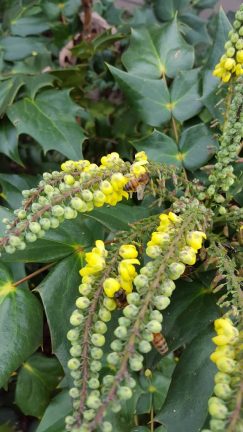 |
| Mahonia bealei, the Leatherleaf mahonia, is in full bloom now (perfectly normal for this plant!) and is abuzz with honeybees. The native plant purists abhor this plant and it can be–admittedly–invasive in some locations. But if you’ll take a few minutes to go out–after flowering is completely finished!–and cut off the clusters of berries, you’ll effectively eliminate the seedling problem and still feed the bees! |
So, really. What am I going to do about all of these things that are out too early? For the most part, nothing. I’ll cover a few noses that are easily covered, but beyond that, Mother Nature must take its course. You’ll run yourself ragged trying to protect everything in the garden and as I said earlier, while you may lose some blooms (you can pretty much scratch the hydrangeas this year), the plants aren’t going to die. If they do, it’s a gardening opportunity. I never have enough room for new plants, anyway!

